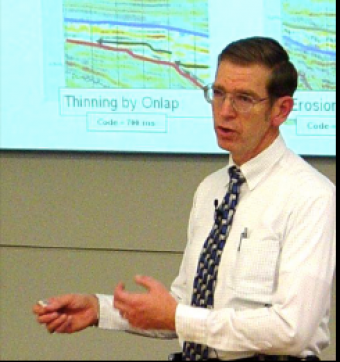NOTE: IF YOU ARE DOING MORE OF A GEOLOGICAL EMPHASIS, you may want to skip this lesson.
The class is divided into three (3) segments: 1) a review of the previous exercises, 2) the lecture, and 3) an introduction to this lesson's exercise. The review of the previous exercise (Exercise 17a and 17b) are contained with that lecture material in InClass, and should take ~17 minutes to explain. The lecture material contained here has 26 slides and will take ~40 minutes to explain. Lastly, the introduction to this lesson's exercise has five (5) slides and will take ~8 minutes to explain. Thus, this lesson's material will take ~65 minutes to discuss and explain.
In the lesson exercise presented here, students will determine the surface area for a 3D survey given a subsurface target of 20 x 24 km. The exercise is a simple “cookbook” that walks students through some simple calculations. The main objective of the survey is to evaluate an amplitude anomaly (Figure 1), which shows a simple anticline and an amplitude anomaly that extends down-structure to the indicated contour.
Students have to figure out the amount of extra area to capture diffractions around the edge of the image area, and the surface area for fold to build up (drop off) as we start (finish) each seismic line. Students should not work more than about 15 minutes on this exercise.
After this lesson, students should be able to:

This course, based on teaching material from Dr. Fred Schroeder (formerly of Exxon/ExxonMobil), reflects on the geology and geophysics basics for the petroleum industry. General geology and basic geophysics are not required, but helpful with the material.